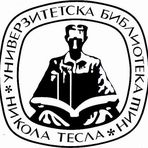Title
Estetski doživljaj muzike u nastavnoj praksi
Creator
Zdravić Mihailović, Danijela 1974-
Copyright date
2015
Object Links
Select license
Autorstvo-Nekomercijalno-Bez prerade 3.0 Srbija (CC BY-NC-ND 3.0)
License description
Dozvoljavate samo preuzimanje i distribuciju dela, ako/dok se pravilno naznačava ime autora, bez ikakvih promena dela i bez prava komercijalnog korišćenja dela. Ova licenca je najstroža CC licenca. Osnovni opis Licence: http://creativecommons.org/licenses/by-nc-nd/3.0/rs/deed.sr_LATN. Sadržaj ugovora u celini: http://creativecommons.org/licenses/by-nc-nd/3.0/rs/legalcode.sr-Latn
Language
Serbian
Cobiss-ID
Theses Type
Doktorska disertacija
description
Datum odbrane: 13.04.2016.
Other responsibilities
mentor
Jevtić, Bisera 1968
član komisije
Suzić, Nenad 1950-
član komisije
Bojović, Žana 1966-
član komisije
Cvetković, Sonja 1963-
član komisije
Maksimović, Jelena 1977-
Academic Expertise
Društveno-humanističke nauke
University
Univerzitet u Nišu
Faculty
Filozofski fakultet
Group
Departman za pedagogiju
Alternative title
Aesthetic experience of music in the teaching practice
Publisher
[D. Zdravić Mihailović]
Format
309 listova
description
Prilozi: listovi 282-309
description
Pedagogy
Abstract (en)
This paper deals with the role and importance of the aesthetic experiencing of music
in the music high school teaching practice.
The theoretical part of this paper presents the analysis of the relevant theoretical
terms, where the central part stands for the aesthetic experiencing in the context of the
aesthetic education, as well as the components of the aesthetic experiencing – the emotional
and the intelectual ones. Besides, the theoretic part contains also goals, tasks and results of
teaching in the school subjects included into the research, didactic and methodological issues
of teaching and dimension of competences of music high school students.
The aim of our investigation is pointed to the examination of the role and importance
of the aesthetic experiencing of music in the process of teaching in the second, third and
fourth classes of the music high school. The appointed aim of the investigation was realized
by means of instruments SUD-KU (Attitudes Scale of students about the role of the aesthetic
experiencing in the curriculum of the music high school), SUZ-KO (Attitudes Scale of
students about the presence of competences in the music high school), used for examination
of cognitive, emotional, social and working competences of the students, while the
instrument SPINO (Scale of positive and negative feelings) was used for examining of the
emotions of the students during the teaching. The sample was made of 311 of students of the
second, third and fourth classes of the music high schools in the cities of Niš, Leskovac,
Kraljevo, Kruševac and Negotin.
Within the empirical part of the paper there are results of the investigation which
show that the teaching of theoretical and performing subjects are characterized by the positve
aesthetic experiencing of music. Through the selfevaluation of the students of the music high
schools it was proved that most of the students have emotional, social and working
competences, yet not the cognitive competences. Since the aesthetic experiencing of music in
our investigation was concidered in the context of the aesthetic education, we have
investigated also the presence of the principles of versatility and creativity in teaching in the
music high schools. The investigation showed that these principles are present enough in the
teaching and that the connection between the theoretical subjects and the subjects based on
the performing music is on a satisfactory level. That was especially proved by the
investigation of the relationship between delight in being tought and the aesthetic experience
of music in theoretical and performing subjects, so we concluded that the students of the
music high schools are motivated for being tought. If we speak about the teacher as one of the
6
important facors in cultivating of the aesthetic experiencing of the students, we concluded
that in teaching of theoretical subjects his influence on the aesthetic experiencing is evident
indirectly, through competences, while in teaching of harmony teachers influence on the
aesthetic experiencing also directly and through the working competences. On the other hand,
in stirring the aesthetic experiencing in performing subjects teachers do not have an important
role either directly or through developing of competences. The obtained results of the
investigation showed that for students of various departments (Theoretical and Vocal-
Instrumental), as well as of different sex and age, the aesthetic experiencing of music in the
teaching practice is equally important and that the students of the Music High School in Niš
have the most prominent aesthetic experiencing in teaching the performing subjects – choir
and orchester.
Our investigation showed that the teacher has an important role in cultivating the
aesthetic experiencing in teaching, especially in teaching harmony. The teaching of
theoretical and performing subjects is not only characterized by the aesthetic experiencing, it
turned out that the aesthetic experiencing of music itself, as a unity of emotional and
intelectual, makes it possible for connecting various music disciplines in teaching practice
and has an important role in motivating the students helping in this way in strengthening the
competences.
Authors Key words
estetski doživljaj, estetsko vaspitanje, srednja muzička škola, motivacija
učenika, pozitivne i negativne emocije, nastavnik, kompetencije učenika
Authors Key words
aesthetic experiencing, aesthetic education, music high school, motivating the
students, positive and negative emotions, teacher, competences of students
Classification
37.036:78.01
Subject
371.3:78(043.3)
Subject
S 270
Type
Elektronska teza
Abstract (en)
This paper deals with the role and importance of the aesthetic experiencing of music
in the music high school teaching practice.
The theoretical part of this paper presents the analysis of the relevant theoretical
terms, where the central part stands for the aesthetic experiencing in the context of the
aesthetic education, as well as the components of the aesthetic experiencing – the emotional
and the intelectual ones. Besides, the theoretic part contains also goals, tasks and results of
teaching in the school subjects included into the research, didactic and methodological issues
of teaching and dimension of competences of music high school students.
The aim of our investigation is pointed to the examination of the role and importance
of the aesthetic experiencing of music in the process of teaching in the second, third and
fourth classes of the music high school. The appointed aim of the investigation was realized
by means of instruments SUD-KU (Attitudes Scale of students about the role of the aesthetic
experiencing in the curriculum of the music high school), SUZ-KO (Attitudes Scale of
students about the presence of competences in the music high school), used for examination
of cognitive, emotional, social and working competences of the students, while the
instrument SPINO (Scale of positive and negative feelings) was used for examining of the
emotions of the students during the teaching. The sample was made of 311 of students of the
second, third and fourth classes of the music high schools in the cities of Niš, Leskovac,
Kraljevo, Kruševac and Negotin.
Within the empirical part of the paper there are results of the investigation which
show that the teaching of theoretical and performing subjects are characterized by the positve
aesthetic experiencing of music. Through the selfevaluation of the students of the music high
schools it was proved that most of the students have emotional, social and working
competences, yet not the cognitive competences. Since the aesthetic experiencing of music in
our investigation was concidered in the context of the aesthetic education, we have
investigated also the presence of the principles of versatility and creativity in teaching in the
music high schools. The investigation showed that these principles are present enough in the
teaching and that the connection between the theoretical subjects and the subjects based on
the performing music is on a satisfactory level. That was especially proved by the
investigation of the relationship between delight in being tought and the aesthetic experience
of music in theoretical and performing subjects, so we concluded that the students of the
music high schools are motivated for being tought. If we speak about the teacher as one of the
6
important facors in cultivating of the aesthetic experiencing of the students, we concluded
that in teaching of theoretical subjects his influence on the aesthetic experiencing is evident
indirectly, through competences, while in teaching of harmony teachers influence on the
aesthetic experiencing also directly and through the working competences. On the other hand,
in stirring the aesthetic experiencing in performing subjects teachers do not have an important
role either directly or through developing of competences. The obtained results of the
investigation showed that for students of various departments (Theoretical and Vocal-
Instrumental), as well as of different sex and age, the aesthetic experiencing of music in the
teaching practice is equally important and that the students of the Music High School in Niš
have the most prominent aesthetic experiencing in teaching the performing subjects – choir
and orchester.
Our investigation showed that the teacher has an important role in cultivating the
aesthetic experiencing in teaching, especially in teaching harmony. The teaching of
theoretical and performing subjects is not only characterized by the aesthetic experiencing, it
turned out that the aesthetic experiencing of music itself, as a unity of emotional and
intelectual, makes it possible for connecting various music disciplines in teaching practice
and has an important role in motivating the students helping in this way in strengthening the
competences.
“Data exchange” service offers individual users metadata transfer in several different formats. Citation formats are offered for transfers in texts as for the transfer into internet pages. Citation formats include permanent links that guarantee access to cited sources. For use are commonly structured metadata schemes : Dublin Core xml and ETUB-MS xml, local adaptation of international ETD-MS scheme intended for use in academic documents.


